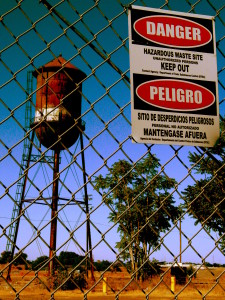Worse, there are 678 more drums packed with the same kitty litter, and it doesn’t look like the people at Los Alamos National Laboratories (LANL) have any plans to proactively do something about it.
Since it’s in the public domain, I’m reprinting William Boardman’s article where I found out about this. It originally ran on Reader Supported News.
I think he’s totally wrong about why this kitty litter was chosen. As a cat owner who used to use clay cat liter and now uses organic ones, I think I can shed some light on that. And I think the implications for nuclear policy worldwide need to be pointed out.
In other words, that part was 99% likely an honest mistake, and the major human error was in the failure to update the storage regulations. The failure to deal with the remaining 678 drums, however, is criminal stupidity and should be dealt with before there are more explosions.
But exploding kitty litter is the least of it. The instructions we pass on about how to “safely” store nuclear waste need to last 250,000 years! That’s how long it takes plutonium to become mostly inert (it never goes away completely). Not only have we never built a container that has lasted a quarter of a million years, we’ve never had a language that long. We are making an assumption that future generations will be able to understand our instructions and replace the storage drums when they wear out. Meanwhile, we’re bombarding them with highly radioactive waste that shortens their lifespan. Radwaste has this tendency to embrittle and corrode things.
Factor in accidents (far more prevalent than most people realize; there have been more than 100 significant nuclear accidents), security concerns, environmental consequences of the entire fuel cycle. Every one of these provides the potential of grave human error with catastrophic results. Large areas of the Ukraine are still sealed off after Chernobyl, almost 30 years ago.
Now add in nuclear’s wretched economics, and the availability of safer, cheaper, cleaner renewable energy resources. We have absolutely no need to go down this road. And developing nuclear power may turn out to be the second-worst act of hubris in our very hubristic history; the first is nuclear power’s older brother: nuclear weapons.
Kitty Litter Shuts Down Sole US Nuclear Weapons Waste Facility
By William Boardman, Reader Supported News
07 April 15
More links at original site:
https://readersupportednews.org/opinion2/277-75/29496-focus-kitty-litter-shuts-down-sole-us-nuclear-weapons-waste-facility
U.S. nuclear weapons buildup ignores waste dangers
Now it’s official: using the wrong kitty litter can cause a severe and expensive nuclear accident at the nation’s unique underground radioactive waste containment facility, shutting it down indefinitely. <https://energy.gov/em/downloads/technical-assessment-team-report>
What’s NOT official yet is why the Los Alamos National Laboratory (LANL) used organic kitty litter that caused the nuclear waste accident in the first place, or why LANL used that kitty litter in some 678 other drums of radioactive nuclear weapons waste now located at LANL and other locations. It’s also NOT official that the wrong kitty litter was deliberately and deceitfully used for more than a year. Nor is it yet clear why the federal government, having violated New Mexico environmental laws, refuses to pay the state $54 million in fines for federal law-breaking.
Last winter, the U.S. Department of Energy (DOE) appointed a Technical Assessment Team of independent experts from other government labs, and the team spent most of a year investigating the 2014 Valentine’s Day radiation-release accident at New Mexico’s federal Waste Isolation Pilot Project (WIPP). On March 26, 2015, the team produced a 277-page report that concluded that radiation was released from the facility when a single container (Drum 68660) over-heated and failed because the nuclear weapons waste it contained was packed with the wrong kind of kitty litter. That kitty litter was “chemically incompatible” with the other contents of the drum, causing it to overheat, creating gases that forced open the lid in a “thermal runaway” that led to the spill that released radiation to the environment and that still renders a large section of the underground storage area lethal to humans.
The assessment team concluded that the February 14, 2014, drum failure took about 70 days to develop before the drum was breached. The accident released radioactive isotopes of Uranium, Plutonium, and Americium in uncertain amounts that are officially thought to be relatively small. As of early April 2015, Drum 68660 is the only drum that has failed. The experts determined that there were other containers in which radioactive waste was packed with the wrong kitty litter, and that any of these might fail, although they say they believe another failure is unlikely.
In part because the accident site remains largely inaccessible, the assessment team wrote that it “could not determine the cause of the drum breach with absolute certainty.”
Los Alamos National Laboratory’s multiple radiation risks continue
While most of the drums of nuclear weapons waste laden with organic kitty litterare already underground at WIPP, there are an estimated 113 in temporary storage in Texas and 57 remaining at LANL. One of the drums at LANL is a “sibling drum” to the one that burst underground. The two drums were packed with waste from the same “parent drum” and with the same Swheat Scoop kitty litter, but other elements of their contents were slightly different. The drum still at LANL is monitored for heat and remains intact. LANL has shipped more than 1,000 drums of waste to WIPP since it opened in 1999. Remaining LANL waste stored above ground on-site was threatened by wildfire in 2011 and remains near an earthquake fault line.
The DOE assessment team did not address the question of why the waste packing process at Los Alamos stopped using non-organic kitty litter as usual and switched to Swheat Scoop. The World Nuclear Association, an industry group in London, explains the kitty litter mix-up by saying: “The DOE did not specify its preferred brand…. However, SwheatScoop happens to be made from wheat and therefore contains carbohydrates which provided fuel for a chemical reaction with the metal nitrate salts being disposed of.” Each 55-gallon drum of nuclear waste typically includes about 50 pounds of kitty litter.
Rumors that the accident at WIPP was caused by the wrong kitty litter used by LANL surfaced soon after it happened. In May 2014, New Mexico’s Environment Department secretary, Ryan Flynn, issued a formal order to LANL to secure the drums with the wrong kitty litter, saying in part:
Based on the evidence presented to NMED, the current handling, storage, treatment and transportation of the hazardous nitrate salt bearing waste containers at LANL may present an imminent and substantial endangerment to health or the environment.
Was LANL cutting safety corners to cut costs?
In November 2014, after a six-month investigation, the Santa Fe New Mexican portrayed LANL as behaving either incompetently, or with reckless disregard for safety, or with something like criminal negligence – perhaps a mixture of all three. Motivating LANL malfeasance, the paper suggests, was the desire of the private contractors running the lab to meet the June 30, 2014, deadline for clearing waste from the site, thereby protecting and extending its $2.2 billion annual operating contract with the U.S. Energy Department as well as another $80 million a year for managing LANL.
Like so much of the U.S. nuclear weapons program, LANL is a cozy, profitable, corporate-welfare monopoly for a private consortium calling itself Los Alamos National Security. The Delaware Limited Liability Company was formed eight years ago by four entities: Babcock & Wilcox Technical Services, URS Energy and Construction, Bechtel, and the University of California. As stated in its by-laws, the company purpose is “to manage and operate the Los Alamos National Laboratory in a manner that furthers the interests of the national security and advances the DOE/NNSA missions, programs and objectives in accordance with the terms of the Prime Contract.” In other words, it is a privately held national security profit center that, according to Bloomberg, “engages in the businesses of nuclear defense programs, facilities management, science and technology to homeland security challenges, and safety and security.”
Los Alamos National Security LLC is, by its very nature, a limited liability conflict of interest in which at least one conflict is between profit and security.
Santa Fe New Mexican lays out tough case against LANL
As viewed by the New Mexican, the parent company, Los Alamos National Security, allowed its employees at LANL to take numerous actions that could protect the company’s profits by risking the security of others. The gambit appears to have failed by just one drum. Its elements, perpetrated or allowed by LANL employees or contractors, included, according to the New Mexican:
• … workers packaging the waste came across a batch that was extraordinarily acidic, making it unsafe for shipping. The lab’s guidelines called for work to shut down while the batch underwent a rigid set of reviews to determine how to treat it, a time-consuming process that jeopardized the lab’s goal of meeting the deadline. Instead, the lab and its various contractors took shortcuts in treating the acidic nuclear waste, adding neutralizer and a wheat-based organic kitty litter to absorb excess liquid.
• Documents accompanying the drum, which were supposed to include a detailed description of its contents … made no mention of the acidity or the neutralizer, and they mischaracterized the kitty litter as a clay-based material – not the more combustible organic variety that most chemists would have recognized as hazardous if mixed with waste laden with nitrate salts….
• Documents and internal emails show that even after the radiation leak, lab officials downplayed the dangers of the waste – even to the Carlsbad managers whose staff members were endangered by its presence – and withheld critical information from regulators and WIPP officials investigating the leak.
• The waste container that ultimately burst would not have met federal transportation standards to get on the road from Los Alamos to Carlsbad, nor would it have been accepted at WIPP, if its true ingredients had been reported by the lab.
• In documents filed with the New Mexico Environment Department before the accident, LANL reported that the waste in the drum that would later burst “is stable and will not undergo violent chemical change without detonating,” and “there is no indication that the waste contains explosive materials, and it is not capable of detonation or explosive reaction. The materials in the waste stream are therefore not reactive wastes.
• LANL has never publicly acknowledged the reason it switched from clay-based litter to the organic variety believed to be the fuel that fed the intense heat.
• Organic kitty litter may have been mixed in up to 5,565 containers of waste at LANL starting in September 2012 that were incorrectly labeled as holding inorganic litter, according to an assessment conducted by WIPP personnel.
LANL did not respond to inquiries by RSN seeking an explanation for the change from inorganic to organic kitty litter during 2012-2014.
Commenting on the story in the New Mexican, Greg Mello of the Los Alamos Study Group wrote in part: “The treatment processes LANS [the LLC] used were illegal as well as dangerous. Shipping the waste was illegal. Providing the fallacious manifest that accompanied the drums was illegal. Failing to provide accurate information after the fact when NMED asks for it was and is illegal.”
In the most recent study group bulletin, Mello notes that not every misdeed in the nuclear world will reach the public and cites an example from December 2014 when eight people at LANL were apparently contaminated with Plutonium but there was no news coverage.
Nuclear safety is an expensive mirage, all for the sake of nuclear war
The cost of failure of the single drum contaminated with organic kitty litter will almost surely run into the hundreds of millions of dollars. WIPP alone estimates its recovery plan will cost at least $500 million, and an additional $200 million or so for an improved, new ventilation system. These estimates do not include the additional costs of holding the nuclear waste stream while WIPP is closed, or the cost of improvement and compliance at LANL or any other facility.
When it opened in 1999, WIPP was supposed to have a 10,000 year leak-proof design life protecting the public from nuclear weapons waste radiation. That design life turned out to be only 15 years of safety, although further releases of radiation since Valentine’s Day 2014 have apparently been limited.
The Department of Energy says it is committed to reopening WIPP by March 2016, at least for partial operation, but that’s uncertain, since no one has ever tried to fix an underground nuclear waste facility before. Meanwhile, the ceiling of the underground salt cave had a significant collapse in January, when a section of ceiling 8 feet by 8 feet and two feet thick fell in a non-contaminated section of the one square mile storage area. As WIPP management acknowledged at the time: “This event highlights the need to continue prioritizing roof bolting and ground control in both the contaminated and uncontaminated areas of the WIPP underground facility in order to ensure safety and habitability in the underground. This area was originally scheduled to be re-bolted during the annual outage in February 2014.”
In March, more than a year after Drum 68660 burst, decontamination of the underground area began, as reported by WIPP: “Employees are using a modified piece of agricultural spraying equipment that allows them to apply a fine water mist to the walls and floor. The water dissolves the salt and washes it down to the floor. When the salt recrystallizes, it encapsulates the contamination and prevents any resuspension of radioactive particles.”
And now the federal government has reversed its past practice of paying fines for violating state laws and regulations. In December 2014, New Mexico’s Environment Department levied a total of $54 million in fines on the federal (outsourced) operations at WIPP ($17.7 million) and LANL ($36.6 million). Now the Energy Department is taking the position that it would be illegal to pay New Mexico’s fines, even though it has done so in the past. New Mexico is reportedly preparing a new order against WIPP, LANL, and others with fines totaling $100 million.
Underlying this struggle over the safety of nuclear weapons waste is the Obama administration’s perpetuation of longstanding reliance on a massive nuclear weapons force comprising more than 7,500 warheads, more than 2,000 of which are presently deployed around the world. The Obama administration has embarked on a program of improving and expanding the American nuclear force. A key element of that program is the fabrication of Plutonium pits (nuclear bomb triggers).
Making these essential elements of American weapons of mass destruction has been assigned to the Los Alamos National Laboratory, even though LANL has demonstrated its ability and willingness to gamble on lying about using the wrong kitty litter.
——————————
William M. Boardman has over 40 years experience in theatre, radio, TV, print journalism, and non-fiction, including 20 years in the Vermont judiciary. He has received honors from Writers Guild of America, Corporation for Public Broadcasting, Vermont Life magazine, and an Emmy Award nomination from the Academy of Television Arts and Sciences.
Reader Supported News is the Publication of Origin for this work. Permission to republish is freely granted with credit and a link back to Reader Supported News.





